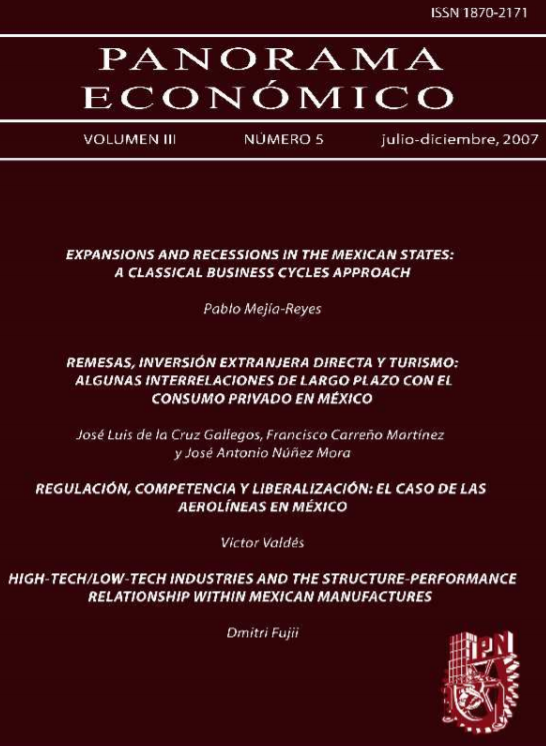Remesas, inversión extranjera directa y turismo: Algunas interrelaciones de largo plazo con el consumo privado en México
Contenido principal del artículo
La presente investigación realiza un estudio de causalidad multivariada entre el consumo privado, la inversión extranjera directa, las remesas y los ingresos por turismo. Para ello se instrumenta un Vector de Corrección de Error, el cual permite estudiar la causalidad para series integradas y que además se encuentran cointegradas. Adicionalmente, la metodología permite estudiar tanto la exogeneidad débil de las variables, como el sentido de las interrelaciones causales existentes entre las mismas. Los resultados señalan la presencia de una correlación positiva y causal de la inversión extranjera directa, las remesas y los ingresos por turismo hacia los principales componentes del consumo privado de México: bienes durables, no durables y servicios. En base a dichos resultados es plausible indicar la existencia de evidencia que indica una relación de largo plazo entre una parte del bienestar de la población mexicana y una parte de los ingresos que llegan al país del exterior.
Acevedo, E. (2002), “Causas de la recesión en la industria maquiladora”, Momento Económico. No. 124, Noviembre-Diciembre 2002, pp. 11-25.
Attanasio O. y Székely, M. (2001), “Wages Shocks and Consumption Variability in Mexico during 1990s”. Research Department Working Paper 451. Washington, DC, United States: Inter American Development Bank, Research Department.
Balaguer, J. y Cantavella, J. (2002), “Tourism as a long-run economic growth factor: the Spanish case”, Applied Economics, 2002, Vol. 34, 877-884.
Basok, T. (2000), “Migration of Mexican seasonal farm workers to Canada and development: Obstacles to Productive Investment”, The International Migration Review; Primavera 2000; 34, 1.
Bauer, T., Haiseken-Denew, J. y Schmidt, C. (2004), “International Labor Migration, Economic Growth and Labor Markets - The Current State of Affairs”, RWI Discussion Paper, No. 20.
Bencivenga, V., Smith, B. (1997), “Unemployment Migration and Growth”, The Journal of Political Economy; Vol. 105, No. 3.
Benito, A. (2004), “Does Job Insecurity affect household consumption”, Working Paper 220, Banco de Inglaterra.
Bhawagthi, J. y Srinivasan, T. (1979), “Trade policy and development”, en International Economic Policy: Theory and Evidence, (Eds) R. Dornbusch y J. Frenkel, Johns Hopkins.
Borjas, G. J. (1991), “Immigration and Self-Selection”, en J. M. Abowd y R. B. Freeman (eds.), Immigration, Trade, and the Labor Market. Chicago and London: University of Chicago Press, 29-76.
Borjas G. (1999), “Immigration and welfare magnets”, Journal of Labor Economics; 17, 4.
Brenner, L. y Aguilar A. (2002), “Luxury Tourism and Regional Economic Development in Mexico”, The Professional Geographer, Vol. 54, 500-520.
Britton, S. (1981), “Tourism, Dependence and Development: a Mode of Analysis”. Development Studies Center Occasional Paper No. 23, Canberra: National Australian University.
Brohman, J. (1996), “New Directions in Tourism for Third World Development”, Annals of Tourism Research, Vol. 23, 48-70.
Bureau of Labor Statistics (2006), “International Comparison of Hourly Compensation Costs for Production Workers in Manufacturing, 2004”.
Cass, D. (1965), “Optimum Growth in an Aggregative Model of Capital Accumulation”, Review of Economics Studies, Vol. 32, 233-240.
Caves, R. (1974), “Multinational firms, competition and productivity in host-country markets”, Economica, Vol. 41, 176-93.
Caves, R. (1996), Multinational Enterprise and Economic Analysis, 2nd edn, Cambridge University Press, Cambridge.
Chiquiar, D. y Hanson D. (2005), “International Migration, Self-Selection, and the Distribution of Wages: Evidence from Mexico and the United States”, The Journal of Political Economy, Vol. 113, 239-281.
Cheng L. y Yang, G. P. (1998), “Global interaction, Global inequality, and the migration of the highly trained to the United States”, The International Migration Review, Vol. 32, No. 3.
Clancy, M. (1999), “Tourism and Development: Evidence from Mexico”, Annals of Tourism Research, Vol. 26, 1-20.
Conesa, A. (1998), “Pass-through del Tipo de Cambio y del Salario: Teoría y Evidencia para la Industria Manufacturera en México”, Documento de Investigación 199803, Banco de México.
Consejo Nacional de Población (2004), Situación demográfica de México, 2004, CONAPO, México.
Consejo Nacional de Población (2005). Migración Internacional. Migración mexicana hacia Estados Unidos, Consultado en: http://www.conapo.gob.mx/mig_int/03.htm.
De La Cruz, J. y Núñez, J. (2005a), “Determinantes externos del consumo privado en México”, Análisis Económico, No. 44, 283-296.
De La Cruz, J. y Núñez, J. (2005b), “Importaciones de EUA: posibles efectos de la competencia china para México”, en A. Sánchez (coordinador), Procesos de Integración Económica de México y el Mundo, EON y Universidad Autónoma Metropolitana, Distrito Federal.
De La Cruz, J. y Núñez, J (2006), “Comercio internacional, crecimiento económico e inversión extranjera directa: evidencias de causalidad para México”, Revista de Economía Mundial, No. 15.
De La Cruz, J. (2007), *México 1982-2006: crisis social de un modelo económico*, en revisión para su publicación.
De Mello, L. (1997), “Foreign Direct Investment in Developing Countries and Growth: A Selective Survey”, Journal of Development Studies, Vol. 34, 1-34.
De Mello, L. (1999), “Foreign Direct Investment Led Growth: Evidence from Timeseries and Panel Data”, Oxford Economic Papers, Vol. 51, 133-51.
Dunning, J. (1988), “Location and Multinational Enterprise: A neglected factor”, Journal of International Business Studies, Vol. 29, No. 1.
Dunning, J. (1993), Multinational Enterprises and the Global Economy, Addison-Wesley.
Dussel, E., Galindo L. y Loria E. (2003), “Condiciones y efectos de la inversión extranjera y directa del proceso de integración regional en México durante los noventa. Una perspectiva macro, meso y micro”, BID-INTAL, Facultad de Economía, Universidad Autónoma de México y Plaza y Valdés.
Eller, M., Haiss, P. Y Steiner, K. (2006), “Foreign direct investment in the financial sector and economic growth in Central and Eastern Europe: The crucial role of the efficiency channel”, Emerging Markets Review, Vol. 7, 300-319.
Esquivel, G. y Razo, R. (2003), “Fuentes de la inflación en México, 1989-2000: un análisis multicausal de corrección de errores”, Estudios Económicos, No. 36, 181-226.
Feder, G. (1982), “On exports and economic growth”, Journal of Development Economics, Vol. 12, 59-73.
Fernández, J. (1997), “La política de deuda externa del sector público”, Estudios Económicos, Vol. 12, 133-155.
Frenkel, R. (2003), “Globalización y crisis financieras”, Revista de la CEPAL, No. 80, 41-54.
Fussel, E. (2004), “Sources of Mexico’s Migration Stream: Rural, Urban, and Border Migrants to the United States”, Social Forces; Vol. 82, Academic Research Library pp. 937.
Gray, H. (1970), International Tourism: International Trade. Lexington MA: Heath Lexington Books.
Greenaway, D. (1998), “Does Trade Liberalization Promote Economic Development?”, Scottish Journal of Political Economy, 45, 491-511.
Grossman, G. y Helpman, E. (1990), “Trade, Innovation and Growth”, American Economic Review, Vol. 80, 86-91.
Grossman, G. y Helpman, E. (1991), Innovation and Growth in the Global Economy Cambridge, Mass. MIT press.
Hansen, H. y Rand, J. (2006), “On the Causal Links Between FDI and Growth in Developing Countries”, World Economy, Vol. 29, 21-41.
Hazari, B. y Kaur, C. (1995), “Tourism and welfare in the presence of pure monopoly in the non-traded goods sector”, International Review of Economics and Finance, Vol. 4, 171-177.
Hazari, B. y NG, A. (1993), “An analysis of tourists’ consumption of non-traded goods and services on the welfare of the domestic consumers”, International Review of Economics and Finance, Vol. 2, 3-58.
Hazari, B. y Sgro, P. (1995), “Tourism and growth in a dynamic model of trade”, The Journal of International Trade and Economic Development, Vol. 4, 253-256.
Helpman, E. y Krugman, P. (1985), Market Structure and Foreign Trade, MIT Press, Cambridge.
Huay, L. y Tan, H. (2006), “Technology Transfer, FDI and Economic Growth in the ASEAN Region”, Journal of the Asia Pacific Economy, Vol. 11, 394-410.
INEGI, (2005), Encuesta Nacional de Ingresos y Gastos de los Hogares, México.
Koopmans, T. (1965), “On the Concept of Optimal Economic Growth”, en The Econometric Approach to Development Planning, Amsterdam, North Holland.
Krueger, A. (1980), “Trade policy as an input to development”, American Economic Review, Vol. 70, 188-192.
Lardy, N. (1995), “The Role of Foreign Direct Investment in China’s Economic Transformation”, China Quarterly, 144, 1065-82.
Lea, J. (1988), Tourism and Development in the Third World, London: Routledge.
Lee H. y Tan H. (2006), “Technology Transfer, FDI and Economic Growth in the ASEAN Region”, Journal of Asia Pacific Economy, Vol. 11, 394-410.
Lipsey, R. (2001), “Foreign Direct Investor in Three Financial Crises”, National Bureau of Economic Research, Working Paper No. 8084, Cambridge, Massachusetts.
Lensink, R., Morrissey, O. (2006), “Foreign Direct Investment: Flows, Volatility, and the Impact on Growth”, Review of International Economics, Vol. 14, 478-493.
Liu, X., Burridge P. y Sinclair, P. (2002), “Relationship Between Economic Growth, Foreign Direct Investment and Trade: Evidence from China”, Applied Economics, Vol. 34, 1433-1440.
Liu, X., Song H. y Romilly, P. (1997), “An Empirical Investigation of the Causal Relationship between Openness and Economic Growth in China”, Applied Economics, Vol. 29, 1679-86.
McKinnon, R. (1964), “Foreign exchange constrain in economic development and aid allocation”, Economic Journal, Vol. 74, 388-409.
Núñez J. y Urzúa C. (1996), “The Mexican Intertemporal Budget Constraint: Persistent Signals of an Eventual Collapse”, Estudios Económicos, Vol. 11, 167-180.
Oh, C. (2005), “The contribution of tourism development to economic growth in the Korean economy”, Tourism Management, Vol. 26, 39-44.
Oks, D. y Van Wijnbergen, S. (1993), “México después de la crisis de la deuda: ¿Será sostenible el crecimiento?”, Economía Mexicana, Vol. II, 65-112.
Parantab, B., Chandana C. y Derrick, R. (2003), “Liberalization, FDI and Growth in Developing Countries: A panel cointegration Approach”, Economic Inquiry, Vol. 41, 510-516.
Passel, J., Van Hook, J. y Bean, F. (2004), Estimates of Legal and Unauthorized Foreign Born Population for the United States and Selected States, Based on Census 2000, Report to the Census Bureau. Urban Institute: Washington, DC. June 1.
Ramírez, M. (2000), “Foreign Direct Investment in Mexico: A Cointegration Analysis”, The Journal of Development Studies, Vol. 37, 138-162.
Ramírez, M. (2002), “Foreign Direct Investment in Mexico during 1990s: An Empirical Assessment”, Eastern Economic Journal, Vol. 28, 409-423.
Ramírez, M. (2006), “Is Foreign Direct Investment Beneficial for Mexico? An Empirical Analysis, 1960-2001”, World Development, Vol. 34, 802-817.
Ramsey, F. (1928), “A Mathematical Theory of Saving”, Economic Journal, Vol. 38, 543-559.
Sana, M. y Massey, D. (2005), “Household Composition, Family Migration, and Community Context: Migrant Remittances in Four Countries”, Social Science Quarterly, Vol. 86, 509-528.
SECTUR (2002), El empleo en el sector turístico de México, México.
Sengupta, J. y Espana, J. (1994), “Exports and economic growth in Asian NICs: an econometric analysis for Korea”, Applied Economics, Vol. 26, 342-57.
SHCP (2004), Criterios Generales de Política Económica, México.
Stiglitz, J. (2003), “El rumbo de las reformas. Hacia una nueva agenda para América Latina”, Revista de la CEPAL, No. 80, 7-40.
Todaro, M. (1969), “A Model of Labor Migration and Urban Unemployment in Less Development Countries”, The American Economic Review, Vol. 59 No. 1.
Turner. E. y Martínez., (2003), “Inversión extranjera y empleo en México”, Revista de Análisis Económico, Vol. XVIII, 221-239.
Turnovsky S. (1997), International Macroeconomics Dynamics, Cambridge, Mass. MIT.
Vanwey, L. (2005), “Land Ownership as a Determinant of International and Internal Migration in Mexico and Internal Migration in Thailand”, International Migration Review, 39(1): 141-172.
Wen, M. (2007), “Foreign Direct Investment, Regional Market Conditions and Regional development”, The Economics on Transition, Vol. 15, 125-151.
Yue, C. (1999), “Trade, Foreign Direct Investment and Economic Development of Southeast Asia”, The Pacific Review, Vol. 12, 249-70.
Zarate-Hoyos, G. (2004): “Consumption and Remitances in Migrant Households: Toward a Productive use of Remitances”, Contemporary Economic Policy (ISSN 1074-3529) Vol. 22, No., 4, October 2004, 555-565.
Zhang, K. (2000), “Human Capital, Country Size, and North South Manufacturing Multinational Enterprises”, International Economics, Vol. 53.
Detalles del artículo

Esta obra está bajo una licencia internacional Creative Commons Atribución-NoComercial-SinDerivadas 4.0.







